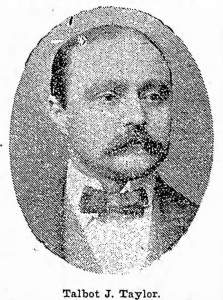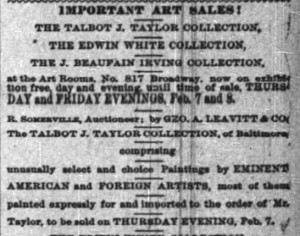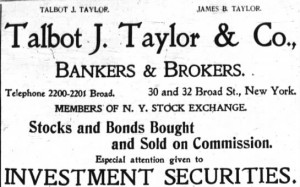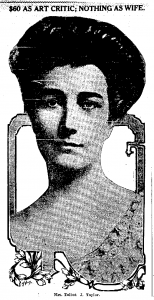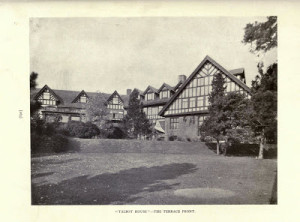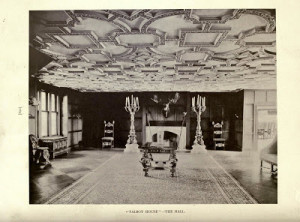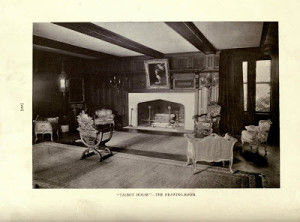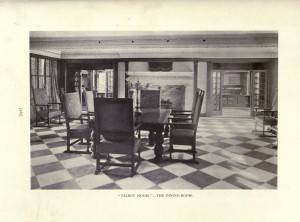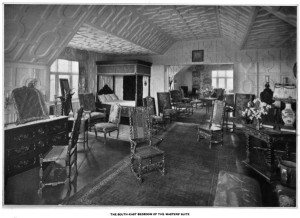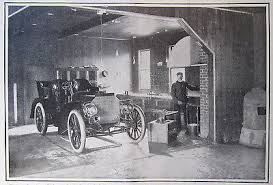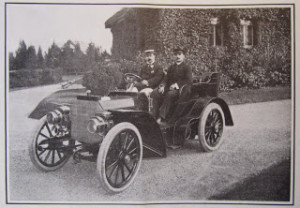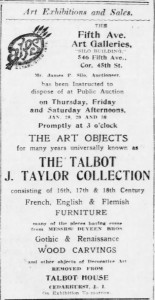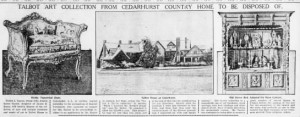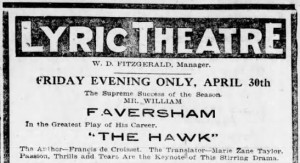Jessica Harwar Keene (1867-1938) was the only daughter of James Keene and Sara Daingerfield, and was the sister-in-law of my wife’s great-grand aunt, Mary Lawrence (1860-1942). Jessica was born in San Francisco but came to New York when her father established himself as the great speculator of Wall Street.
Talbot Jones Taylor (April 25, 1865-1938) came from an established Baltimore family, whose estate became the National Cemetery in the 1930s. His father was apparently an art collector, as this notice appeared in the New York papers after his death:
At the age of sixteen Talbot entered the firm of C. Irwin Dunn in Baltimore. He went on to Mc Kim and Co., then to the National Bank of Baltimore, where he was a note teller. He caught the eye of James Keene. In 1892 Talbot opened his brokerage office.
On May 14, 1892 Jessica married Talbot Jones Taylor in St. John’s Church, Far Rockaway. Delmonico catered the wedding breakfast at the house which was furnished with art and paintings recurred from the elder’s Keene’s house in Newport, which had burnt at the time of one of his financial disasters.
In February 1897 Talbot and his brother James B. Taylor formed a partnership on Wall Street. It became the biggest house on the Street.
1n 1899 Foxhall Keene became a “special partner.” In 1899 Talbot was served with a subpoena by a Grand Jury “presumably in connection with the false
rumors circulating about the Brooklyn Rapid Transit Company.”
On August 1899 Jessica presented her grandfather with his second grandchild, Jessica Keene Taylor (who seems not to have survived). It seemed to be a day of good omen. James Keene
has cleared up specially a lien of B. R. shorts for Miss Taylor against a future rainy day – about $500,000 [$15,000,000 in 2015 dollars]. That is the way the ex-Pine-street free-lance does things. And hardly had the congratulations come about Miss Taylor, when Chacornac won the Futurity for Mr. Keene.
James Keene worked out of his son-in-laws Talbot’s brokerage office. Among the matters he handled was the 1901 manipulation of the initial offering of US Steel as the secret agent of J. P. Morgan.
Perhaps to celebrate this success, James Keene in that year bought a $100,000 ($3,000,000 in 2015 dollars) diamond necklace for his wife, an invalid. As she had no use for it, she gave it to her daughter Jessica.
Mrs. Taylor is thus the possessor of the finest diamond necklace in the United States. It consists of a strand of ninety diamonds of the purest water, so arranged so that they may be worn around the throat of the wearer several times, as pearls are usually worn. Suspended from the center of this glittering strand is a pendant cluster of eight magnificent gems, and from this again is suspended a single diamond, which is said to be the largest and finest stone owned in New York.
In 1903 the Taylor firm failed because of a speculation in a Southern Pacific RR pool, and James Keene admitted a loss of $1,500,000 ($42,000,000 in 2015 dollars).
Mrs. Keene gave land and money for a house for her daughter and son-in law: Talbot House.
Such a house had to be furnished. Talbot knew just the person, Marie Zane Cowles.
Marie Zane originally met Talbot Taylor in 1897 at a house party in Cedarhurst in honor of Lillie Hastings Jerome Onativia (Mrs. Tomasito Luis de Onativia), whose companion Marie Zane had been for many years (more about the Onativias in later blogs). He apparently fell in love with her. Mrs. Taylor complained to the hostess (Lillie Onativia’s niece) who packed Lillie Onativia and Marie Zane off to New York.
Marie went to Europe with Mrs. Onativia, but returned to New York in 1900 and set up as an interior decorator. Her relationship with Mrs. Onativia was rocky. She had loaned Onatvia $3,500.
When the money was not paid on demand Miss Zane brought suit in a San Francisco court. Her former friend put in a bill for money alleged to have been spent on Miss Zane when they were in Europe together. It included such items as $15 for a pair of blue corsets and $115 for a nickeled bicycle.
A California newspaper announced her surprise engagement to another Californian who was visiting New York, William Northrup Cowles. It was a surprise because
Cowles was considered the most confirmed of bachelors, and long ago, when he kept the Arlington in Santa Barbara and made it rather a gay resort, his heart was said to be of adamant.
(The language is, I suspect, more than just a coincidence). Marie married Cowles in December 1901 and divorced him four weeks after the marriage.
A gossip column later explained that Cowles had gone to New York and met Marie.
In New York two old aunts of Marie Zane thought Cowles was too attentive. They laid a trap and a plot. Cowles fell into it. Out of a high sense of chivalry he acceded to the demands of the aunts and marred Miss Zane. He never lived with her and let her get a divorce as soon as she wanted it.
Mrs. Taylor, as we shall see, thought there was another explanation.
Marie, the now Mrs. Cowles, moved into an apartment next to Talbot, and when he moved, she moved also into an apartment directly underneath his.
Talbot hired Marie for $40,000 ($1,000,000 in 2015 dollars) to help him decorate Talbot House. As he later explained
he had met Mrs. Cowles as an expert on rugs, ivories, and other costly bric-à-brac and he had engaged her services in Europe and in this country to pick up for him many objects of art with which to furnish his home.”
Talbot traveled to France with her to buy furniture and ecclesiastical art for Talbot House before the new French law controlling the exportation of antiquities went into effect.
And what a home he had to fill: 30 bedrooms:
A Bedroom (Note the abundance of chairs; this has provoked comments)
Talbot with his 1902 Mercedes
Talbot published a book on his collection.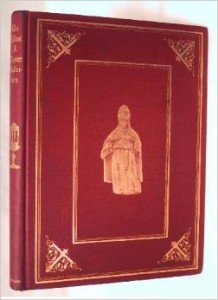
The Talbot J. Taylor collection;furniture, wood-carving, and other branches of the decorative arts;
with one hundred and eighty-seven illustrations.
Jessica took her children to the south for the winter because one child was an invalid. When she returned, she discovered that her husband had given her furs and jewels to his lady friend. She filed for divorce.
Mrs. Taylor claimed the marriage to Cowles, an acquaintance of Talbot’s was engineered purely to provide cover for the relationship. Talbot paid all the expenses of the marriage. She divorced Cowles but was still known as Mrs. William Cowles, a respectable woman, solely to provide cover for the relationship with Talbot.
The court referee found that Talbot had become “unduly intimate” with Marie. Against the denials of Talbot and Mare, was
the testimony of chauffeurs, servants, French hotel employees, elevator boys and maids, and a handwriting expert.
Marie told the papers it was all a misunderstanding, in what the papers called “the opening of Mrs. Cowles vials of wrath.”
“There was nothing but the rankest perjury throughout the entire case…
“There was not a tithe of evidence brought against me…
“…the whole affair is incomprehensible, except as showing what a woman’s spite can do.
Marie insisted her relationship with Talbot was purely a business one. Her eyes wandered to a chest with a photograph.
“There she is…there is the woman who tried to ruin me.” The face was badly scratched with a pencil.
Marie added
“Certain people of very ungentle breeding became millionaires in the gold days of California.
Why was all the mudslinging necessary?
“Gentle folk do not move in that way. It might have gone about l’aimable, as the French say – in a quiet manner, without all these cruel, unneeded charges and the publicity that has been crueler still.
Talbot had given her free rein in the purchases.
“what went into that house was my art, my selections.
Mrs. Cowles did not like the idea of this wealth of furnishings finally passing into the hands of Mrs. Taylor.
Jessica proceeded to auction the stuff that Marie had bought for the house; Talbot tried to stop her but was rebuffed by the court. Mrs. Taylor’s attorney was scathing:
I want the court to know how little right this man with this lady’s disposition of her property….
It was a lucky day for Talbot J. Taylor when, as some people might say, he struck the whimsical fancy of Jessica Keene, Taylor was then living in Baltimore engaged in the rather vague business of real estate, with an income of something like $2,000 a year.
James Keene paid for the wedding trip and gave the newly married couple a $40,000 house in Baltim0re and $2,500 a month. Talbot sold the house and bought a seat on the New York Stock Exchange. Mrs. Keene gave the couple seven acres in Cedarhurst and money to build a house there.
In December 1902…Taylor began very suddenly buying furniture and adding to the house in Cedarhurst. He made an enormous place of it, containing thirty bedrooms, and furniture began pouring in. In July, 1903, he failed. Our affidavits show that in October or November, 1902, he admitted to Mr. Keene that of the $5,000,000 or $6,000,000 in money and securities which Mr. Keene had on deposit with Talbot J. Taylor & Co., Taylor had managed to get rid of $1,200,000 [$33,000,000 in 2015 dollars].
So that is where the money for the antiques came from. The attorney continued
He went on buying furniture and making additions to his house until the time of his failure. T that time, to avoid the disgrace of bankruptcy, Mr. Keene released the claims he had, amounting to $4,000,000 [$112,000,000 in 2015 dollars].
Talbot Taylor and Marie Zane Cowles married in September 1909.
Jessica and the children got Talbot House but moved out and rented it to the Watters family. They had just moved in when
On April 4, 1913 a boiler exploded and a fire destroyed the house. The house was filled with the art and rare books that the Keenes had collected; the loss was over $500,000 [$12,000,000 in 2015 dollars].
In March 1913 Marie, Talbot’s second wife, sued him for divorce. She went on to translate the French play The Hawk by Francis de Croisset – “a love story of modern society life”
Talbot retired to France:
In recent years Mr. Taylor had devoted himself to beautifying his home at Nice. In this endeavor he dwelt especially on the growing of flowers and his horticultural specimens took many first prizes In the Riviera shows.
He died in Nice on April 3, 1938. The first Mrs. Taylor died Christmas Day, 1938.
